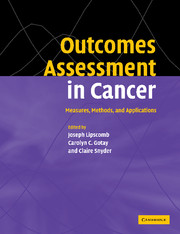Book contents
- Frontmatter
- Contents
- List of contributors
- Acknowledgments
- 1 Introduction to Outcomes Assessment in Cancer
- Health-related quality of life in cancer: general concepts and generic measures
- Assessing health-related quality of life during treatment
- Assessing health-related quality of life across the cancer continuum
- 10 Short-term outcomes of chemoprevention, genetic susceptibility testing, and screening interventions: What are they? How are they measured? When should they be measured?
- 11 Evaluating quality of life in cancer survivors
- 12 Assessing health-related quality of life at end of life
- Measuring the experience and needs of cancer patients and caregivers
- Methodological considerations in applications to cancer outcomes research
- Modern psychometric theory in cancer outcomes research
- Assessing the economic impact of cancer
- Research and policy implications
- Invited papers
- Index
- References
10 - Short-term outcomes of chemoprevention, genetic susceptibility testing, and screening interventions: What are they? How are they measured? When should they be measured?
Published online by Cambridge University Press: 18 December 2009
- Frontmatter
- Contents
- List of contributors
- Acknowledgments
- 1 Introduction to Outcomes Assessment in Cancer
- Health-related quality of life in cancer: general concepts and generic measures
- Assessing health-related quality of life during treatment
- Assessing health-related quality of life across the cancer continuum
- 10 Short-term outcomes of chemoprevention, genetic susceptibility testing, and screening interventions: What are they? How are they measured? When should they be measured?
- 11 Evaluating quality of life in cancer survivors
- 12 Assessing health-related quality of life at end of life
- Measuring the experience and needs of cancer patients and caregivers
- Methodological considerations in applications to cancer outcomes research
- Modern psychometric theory in cancer outcomes research
- Assessing the economic impact of cancer
- Research and policy implications
- Invited papers
- Index
- References
Summary
Introduction
Cancer is a frequent and serious illness with major impact on the quantity and quality of life. For several common cancers, preventive measures and periodic screening can reduce the risk for cancer incidence or, through early detection, lower morbidity and mortality from incident cancers. More recently, genetic testing has been introduced to screen for cancer susceptibility mutations. Presumably, the benefits of screening and early detection are accompanied by net improvements in the quality of life for persons in whom cancers are prevented or detected early. However, both prevention efforts and screening also have the potential to influence quality of life more subtly, either positively or negatively, for the large majority of asymptomatic individuals who would never have developed the cancer.
Faced with an increasing number of effective prevention and screening strategies and technologies, individual patients, health care systems, and policy analysts need accurate assessments of quality-of-life outcomes to inform shared decision making and to conduct relevant decision and cost-effectiveness analyses.– However, there has been little research on short-term effects on quality of life, which may be the predominant effects of chemopreventive or screening interventions.
In this chapter, short-term outcomes are defined, a framework for understanding and measuring these outcomes presented, the quality-of-life domains most relevant to cancer prevention and screening activities explored, the existing literature and tools currently employed to measure outcomes reviewed, methodological challenges highlighted, and recommendations for future studies made.
- Type
- Chapter
- Information
- Outcomes Assessment in CancerMeasures, Methods and Applications, pp. 216 - 240Publisher: Cambridge University PressPrint publication year: 2004
References
- 1
- Cited by



